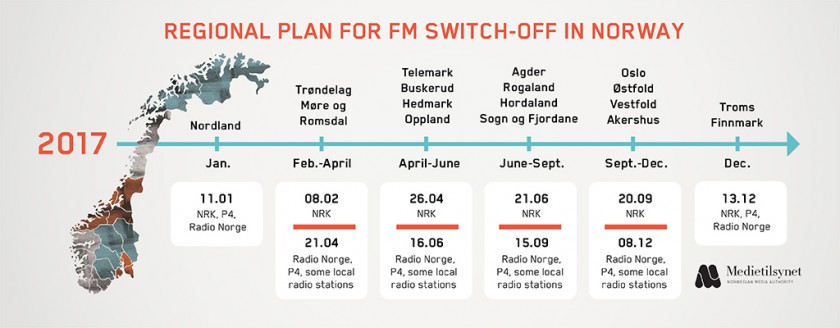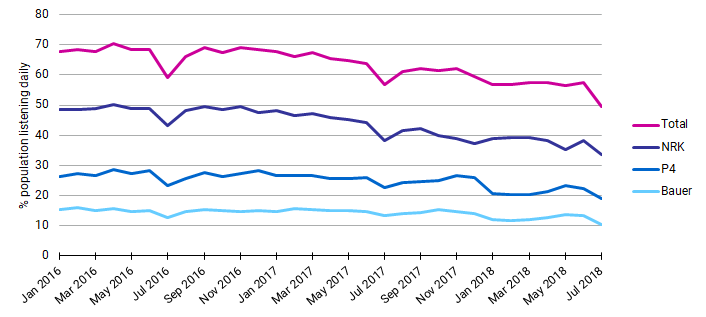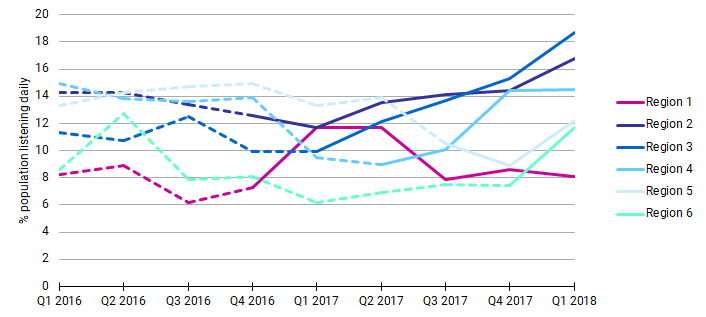
DAB in Norway: will listeners return?
August 16, 2018
Eight months after the switch to digital radio in Norway, what is really happening in the radio market? Is DAB a success?
Norway was the first country worldwide to replace its national FM broadcasts with digital radio. After a year-long phased transition, the last of Norway’s six regions switched off national FM services in December 2017 (Exhibit 1). FM is still available from local radio stations, however the national broadcasters that dominate the market – state-owned NRK and the two commercial operators P4 Group (part of the Swedish media company MTG) and German-owned Bauer Media – now only deliver digital radio services. Almost all stations are using the DAB+ standard.
Exhibit 1: Regional plan for FM switch-off in Norway [Source: Medietilsynet]

To continue listening to the national broadcasters Norwegians needed to purchase digital radios. Cars without factory-installed DAB/DAB+ radios required retro-fitting with adaptors and DAB antennas. By November 2017, 85% of households but just 49% of Norwegian cars had DAB radios. The cost of those devices is being fully borne by Norwegian consumers.
Why switch off FM when both FM and DAB have been co-existing since the mid-1990s? The transition has been largely driven by industry, for economic reasons. Maintaining extensive dual transmission coverage across a country with challenging geography and many remote settlements is expensive. Plus in its 2011 report on the digitisation of radio the Ministry of Culture identified that the ageing FM transmission network, owned by Telenor subsidiary Norkring, would require substantial upgrade and maintenance – costs that would ultimately be borne by the broadcasters. Switching off FM benefits broadcasters by reducing distribution costs.
The advantages of DAB have long been recognised:
- more efficient use of spectrum, enabling broadcasters to deliver multiple program streams rather than a single FM channel
- enhanced audience experience via additional services, including audio, images and text
- less sensitive to interference from adjacent channels
- can deliver an improved sound quality – although this will depend on the bitrate used by the broadcaster. Quality is improved with high bitrates but with a trade-off of fewer program streams.
Almost all (99.7%) of the Norwegian population is within DAB+ coverage. Prior to switch-off there were just five national FM channels – there are now 31 national channels. NRK has three main channels, plus another 12 niche channels, and there are 16 commercial channels.
Nonetheless there is considerable opposition to the FM switch-off. In a December 2017 survey, 56% of respondents were unhappy with the switch to DAB, with just 31% satisfied by the transition. One of the opposition political parties, Senterpartiet, is calling for the re-introduction of FM services. Audiences have declined to record low levels, with less than half of all Norwegians listening to national radio services during weeks 28 to 30 of 2018 (Exhibit 2). NRK has been hardest hit by the decline, with P4 and Bauer experiencing more modest reductions in their total audiences across all channels.
Exhibit 2: Listeners for Norwegian national radio broadcasters by month, 2016 to 2018 [Source: Kantar TNS]

Listeners are unhappy with the cost of replacing FM radios and there are reports of poor audio quality or even no signal from DAB broadcasts.
A bitrate of 192kbit/s is required for a stereo signal on DAB+ to achieve an audio quality comparable to that of FM; audio quality may be degraded at bitrates below 160kbit/s. Bitrates for Norwegian national DAB channels appear to range between 48kbit/s and 128kbit/s – which may be fine for information or talk programs, but unlikely to be acceptable to music lovers.
Many local stations – still on FM – are picking up listeners after the national broadcasters shut down FM services (Exhibit 3).
Exhibit 3: Listeners for Norwegian local radio by region – dotted lines are pre FM shutdown of national broadcasters, suggesting some listeners are switching to local FM radio [Source: Kantar TNS]

Broadcasters are also losing listeners to cross-border radio, mostly Swedish FM stations, which reach around half the Norwegian population. Sweden has no plans to switch off its FM broadcasts – around 35% of the Swedish population are within DAB coverage. In its 2015 report on digital radio the Swedish National Audit Office (NAO) identified numerous risks associated with the proposed switch to DAB, including inadequate investigation of technical options and future industry trends, lack of demand by users and weaknesses in the technical assessment of the proposed transition. Furthermore the NAO’s investigation showed the transition was unlikely to have a positive economic benefit, even in the long-term, due to the costs that would be borne by consumers. As a result of these findings, in 2015 the Swedish Government rejected the proposal to switch to DAB.
As Norwegian national radio audiences dropped, broadcasters’ advertising revenue has also declined. In the first four months of 2018, radio advertising spend fell by 7.8%.
Will Norwegian audiences return to radio? With other platforms available – such as Internet radio, smartphone apps and cross-border FM broadcasts – there is a risk that the Norwegian radio market may not recover from the FM switch-off. So far there has been little sign of any sustained upturn – suggesting that the national broadcasters need to take action to deliver compelling content and resolve quality issues.
